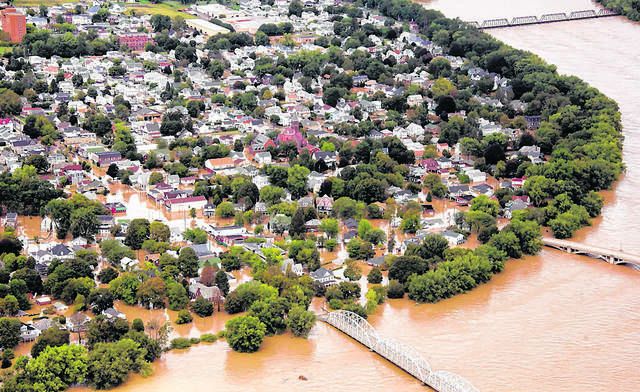Click here to subscribe today or Login.
Approximately 350 Luzerne County properties that flooded eight years ago this month have been bought out and demolished, according to municipal engineering consultant Jim Brozena.
The erasing of structures impacted by record Susquehanna River flooding in September 2011 was funded through Federal Emergency Management Agency and county Community Development Office programs, said Brozena, who has been involved in the majority of buyouts.
Most of the properties were hit in multiple floods and are situated in low-lying areas not protected by the Wyoming Valley Levee along the Susquehanna, including parts of Shickshinny borough and Conyngham and Nescopeck townships, he said.
Municipalities must agree to own and maintain buyout properties and keep them undeveloped.
“It will remain open space forever,” Brozena said.
Buyouts benefit both property owners and municipalities, he said. Occupants of the structures no longer have to deal with flooding, and municipalities don’t have to worry about evacuating them and putting first responders at risk, he said.
The removal of structures has dramatically altered the appearance of some neighborhoods, including River Road in Jenkins Township near the Eighth Street Bridge and the Plainsville section off North River Street in Plains Township.
However, Brozena said the only clue for newcomers that structures once stood in some neighborhoods may be roads remaining around empty or almost empty blocks.
Plymouth Township Supervisor Gale Conrad estimated about 75 properties were demolished since 2011 in her municipality, in addition to others following flooding in 2004, 2005 and 2006.
Conrad praised government officials for providing buyout funding to end repeated cycles of post-flood pain — mental, physical and financial — for impacted property owners.
“It just beats the heck out of you,” she said. “It affects work and school, and it’s not over in a few weeks. It can take years to get back on track.”
Like Brozena, Conrad expects the now-cleared lots to flood again and reinforce the decision of former inhabitants to get out.
“We are sad folks have left due to the flood, but we will have other floods,” she said, noting the township is “fortunate” to have land on higher ground available for new development.
West Pittston study
In West Pittston borough, where more than 800 structures were damaged by flooding in 2011, residents have been calling for levee protection.
The county Community Development Office earmarked $225,000 for the borough to complete a feasibility study of flood control options. The office’s funding came from a $25.4 million U.S. Department of Housing and Urban Development allocation to fix lingering damage from Hurricane Irene and Tropical Storm Lee in 2011, which was also used for the buyouts, officials have said.
Wilkes-Barre-based Borton-Lawson is completing the study, with help from sub-contractor Reilly Associates in Pittston and guidance from Brozena.
The study will examine the costs and pros and cons of river dredging, river island removal and both inflatable and permanent levees in addition to the impact of doing nothing, Brozena has said.
Brozena said he expects a public meeting will be held in a few weeks to review the recommendations.





